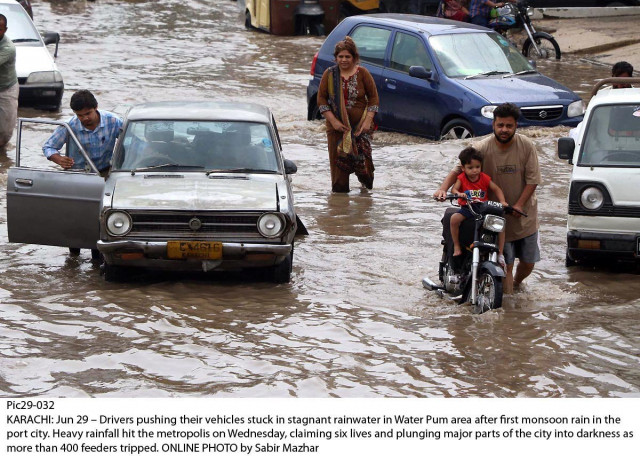
The rain, which started on Wednesday, died down during the day on Thursday – only to lash the metropolis more heavily hours later. And if the Meteorological Department forecasts come true, it will continue to rain until Friday evening.
The major rainwater drains – including Gujjar Nullah, Mehmoodabad Nullah, Shadman 14/A Nullah, Golden Town Nullah, Korangi Nullah and Manzoor Colony Nullah – overflowed swamping the low-lying areas. The Katchi Abadis, or slums, were the worst hit where houses were flooded with knee-deeps rainwater.

Monsoon likely to catch municipal authorities unaware
The underpasses built on different arteries, especially Liaquatabad Underpass, Gharibabad Underpass, Nazimabad Underpass, and Golimar Underpass, turned into swimming pools in the absence of proper drainage arrangements.
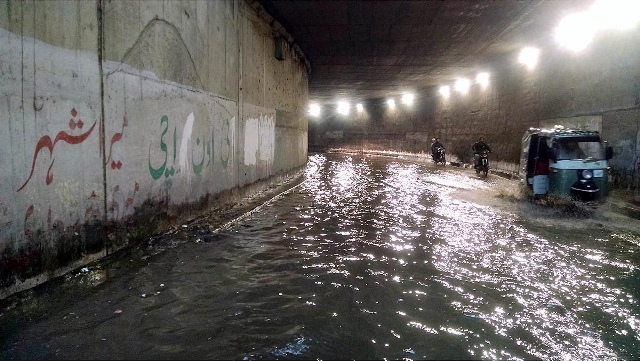
The virtual paralysis of the city exposed the tall claims of the city’s municipal authorities – including District Municipal Corporations, Karachi Metropolitan Corporation and cantonments boards – who boasted of better preparations to deal with monsoon rains.
Buck-passing started immediately. Deputy Mayor Arshad Vohra decried what he called “lack of cooperation and support from the provincial government”. He said comprehensive planning was required to deal with ‘natural disasters’ of this magnitude.
The main arteries, especially University Road, Sharea Faisal, Sir Shah Suleman Road, Shahrah-e-Pakistan, Jahangir Road, Korangi Road, II Chundrigarh Road, MA Jinnah Road Abul Hassan Isphahani Road, Khalid Bin Waleed Road, Tariq Road and Expressway, were inundated with massive traffic snarl-ups.

Monsoon: Dry spell ends as rain lashes country
The K-Electric was also caught ill-prepared as 483 feeders of the power utility tripped, plunging most neighbourhoods of the city into darkness. These included Korangi, Landhi, Nazimabad, Liaquatabad, Malir, Federal B Area, Saddar, Gurumandir, Mehmoodabad, Gulshan-e-Maymar, Orangi Town, and North Karachi.
The power utility said restoration of the feeders would start only after the rain stopped, meaning residents would have to go without electricity for hours.
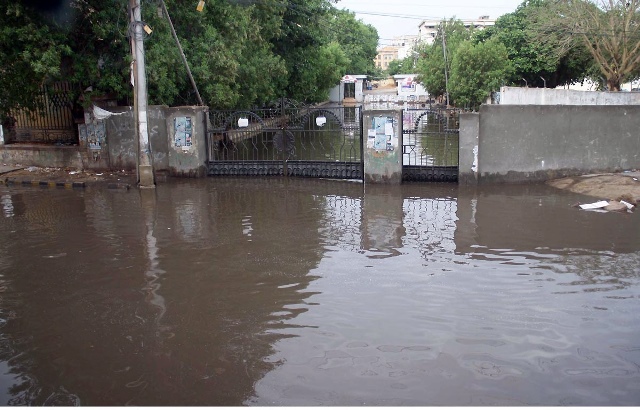
A K-Electric spokesperson advised people to stay away from electricity pylons and transformer to avoid electrocution. But the advice was apparently thrown to the winds by residents as at least six people died after suffering electric shock in Orangi Town, Shah Faisal Colony, Hussainabad, Liaquatabad and Shahrah-e-Noor Jahan areas.
The Sindh Building Control Authority, meanwhile, declared more 100 residential structures dangerous warning residents to evacuate to avoid losses. The authority has also set up an Emergency Centre at the Civic Centre.
According to the Met Office data, the city received over 50 millimeters of rain. “The current monsoon rain spell will continue until Friday evening,” Abdur Rashid, the Director Met Karachi, told a news channel in a telephone interview.

Monsoon rains also lashed several districts in rural Sindh bringing down the mercury. Low-lying areas were inundated, while cities suffered hours-long power outages. At least six people, including three women, were reportedly killed when lightning struck in Tharparkar and Mirpurkhas districts. The rain started on Wednesday with the Met Office recording the highest rainfall of 12 millimetres in Badin district and 8mm in Thatta district.
Apart from Sindh, monsoon rains also lashed different regions of Punjab, Balochistan and Khyber-Pakhtunkhwa. Regrettably, the country lacks a comprehensive flood protection plan to avoid losses in men and material.
Though the top civil leadership has once again swung into action directing the authorities concerned to take preemptive measures in order to avoid loses but they appears to be least concerned about the recently approved National Flood Protection Plan 2015-2025 which requires funds for effective implementation.
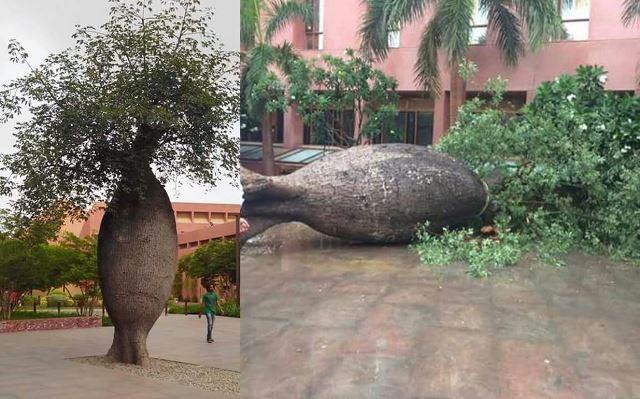
Skies open up as Karachi experiences first monsoon shower
The PC-1 of the 10-year National Flood Protection Plan worth Rs1.77.66 billion is all set to be completed by July end, but so far it is unclear who will provide funds for its implementation, an official told The Express Tribune on condition of anonymity.
National Disaster Management Authority Chairman Lt Gen Omar Mahmood Hayat has meanwhile convened an emergency meeting to review arrangements made by the authority to deal with any untoward situation during the ongoing monsoon rains.
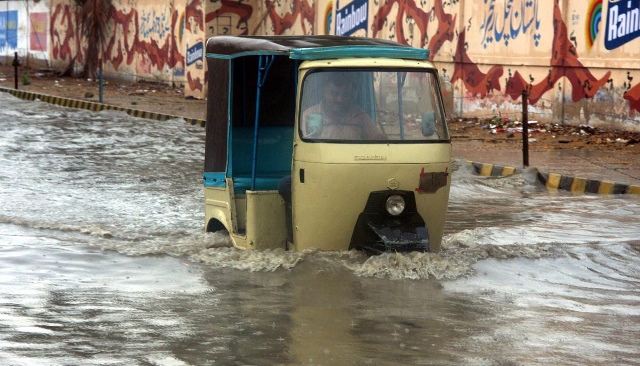
He was briefed about the current situation of water inflow and outflows in the major rivers of the country, road situations, highways/motorways, water situation in the dams among others. Hayat stressed upon the need for strengthening coordination between all the concerned departments during monsoon and to work like a team.
(With additional reporting by our correspondents in Hyderabad and Islamabad)


















COMMENTS
Comments are moderated and generally will be posted if they are on-topic and not abusive.
For more information, please see our Comments FAQ